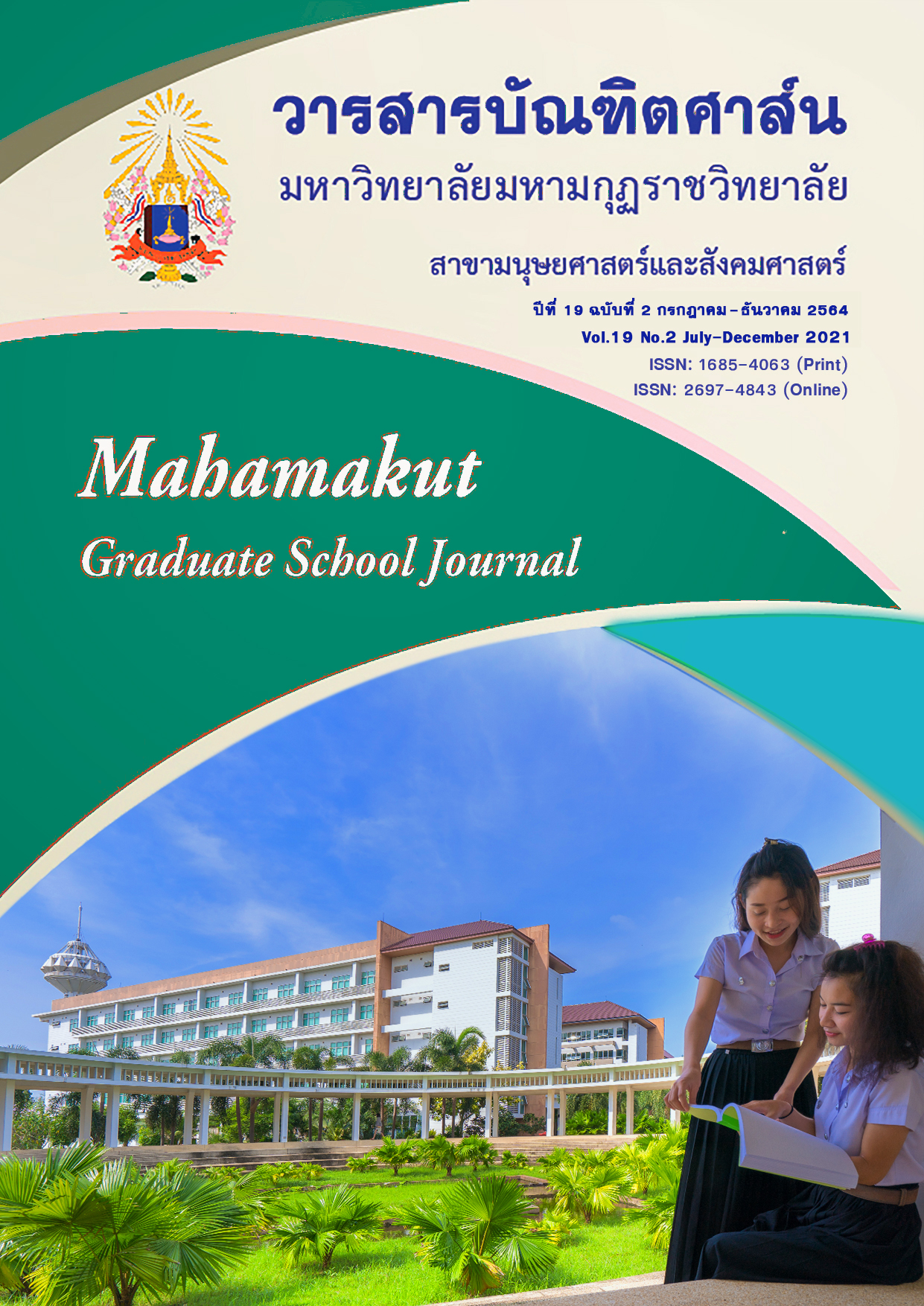ความหลงในฐานะเป็นรากฐานของความเห็นผิดในพระพุทธศาสนา
คำสำคัญ:
ความหลงในฐานะเป็นรากฐานของความเห็นผิด, การศึกษาวิเคราะห์บทคัดย่อ
วิทยานิพนธ์นี้มีวัตถุประสงค์ 1) เพื่อศึกษาความเห็นผิดในพระพุทธศาสนา 2) เพื่อศึกษา ความหลงในพระพุทธศาสนา 3) เพื่อวิเคราะห์การแก้ไขความหลงในฐานะเป็นรากฐานความเห็นผิดในพระพุทธศาสนา ศึกษาค้นคว้าจากคัมภีร์ทางพระพุทธศาสนา ตำราและเอกสารงานวิจัยที่เกี่ยวข้อง ด้วยวิธีศึกษาวิจัยเชิงคุณภาพเอกสาร โดยรวบรวมข้อมูลที่ได้นำมาวิเคราะห์เพื่อหาข้อสรุป
ผลการวิจัยพบว่า :
ความเห็นผิดในพระพุทธศาสนา พบว่าความเห็นผิด (มิจฉาทิฏฐิ) เป็นสิ่งที่เมื่อเกิดแก่ผู้ใดย่อมนำความทุกข์สู่ชีวิตทั้งปัจจุบัน ถึงอนาคต หากไม่สามารถแก้ไขมิจฉาทิฏฐิอันนำไปสู่ความเห็นอันดิ่งลงยากจะถอนออกที่เรียกว่า นิยตมิจฉาทิฏฐิ ซึ่งนิยตมิจฉาทิฏฐินั้นเป็นรากเหง้าของวัฏฏะ หลักธรรมที่ใช้สลัดมิจฉาทิฏฐิ คือ สัมมาทิฏฐิ คือ ความเห็นชอบ หรือความเห็นที่ถูก สัมมาทิฏฐิจะเกิดขึ้นได้ต้องอาศัยปัจจัย 2 อย่าง คือ 1) ปรโตโฆสะ หรือกัลยาณมิตร การได้ฟังสิ่งที่ดีงามจากบุคคลอื่น และ 2) โยนิโสมนสิการ การทำไว้ในใจโดยแยบคาย การคิดถูกวิธี ความรู้จักคิด คิดเป็น คิดอย่างมีระบบ, ต้องฝึกตนเองด้วยสมาธิ โดยมีสติเป็นผู้ควบคุมทำให้เกิดปัญญาและสัมมาทิฏฐิเกิดขึ้นย่อมสลัดมิจฉาทิฏฐิได้
ความหลงในพระพุทธศาสนา พบว่าความหลง (โมหะ) เป็นหนึ่งในอกุศลมูล ถือว่าเป็นอกุศลมูลตัวสำคัญที่หนุนนำให้อกุศลมูลตัวอื่นเกิดขึ้น ความหลง(โมหะ) มีความหมายหยาบกว่า อวิชชา ความไม่รู้ในอริยะสัจ ความหลง จะกำจัดยากเพราะความหลงเป็นอาการจิตที่มืดบอด การกระทำใด ๆ อย่างไร้สติอันตรายมีโทษมาก และคลายช้า โทษที่เกิดในภพหน้าของมนุษย์ที่มีความหลง(โมหะ) ย่อมไปสู่ภพสัตว์เดรัจฉานความเห็นผิด หรือความเห็นที่วิปริต วิปลาสคลาดเคลื่อนจากความเป็นจริง ย่อมมีความหลงเป็นตัวหนุนนำจึงเกิดความเห็นผิด ทำให้เห็นว่า ความเห็นผิด (มิจฉาทิฏฐิ) มีความหมายที่หยาบกว่า ความหลง (โมหะ)
การแก้ไขความหลงในฐานะเป็นรากฐานของความเห็นผิด พบว่าสามารถแก้ใขได้ด้วยหลัก ปัญญา 3 ซึ่งแบ่งออกเป็น 4 ระบบดังนี้ 1.ระบบการศึกษา (สุตมยปัญญา) 2.ระบบการใช้หลักเหตุผล (จินตามยปัญญา) 3.ระบบการพิสูจน์ตรวจสอบ (ภาวนามยปัญญา) 4.ระบบควบคุม (สติ,สัมปชัญญะ,อัปมาทะ) เป็นต้น
เอกสารอ้างอิง
มหามกุฏราชวิทยาลัยมูลนิธิ. พระไตรปิฎกภาษาไทย ฉบับมหามกุฏราชวิทยาลัย พิมพ์เนื่องใน วโรกาสครบ 200 ปี แห่งราชวงศ์จักรี กรุงรัตนโกสินทร์ พุทธศักราช 2525. กรุงเทพมหานคร : โรงพิมพ์มหามกุฏราชวิทยาลัย, 2552.
หนังสือ
นิศา เฃนะกุล. โครงสร้างของพระสัทธรรมในพระพุทธศาสนา. กรุงเทพมหานคร : หอรัตนชัยการ
พระสัทธัมมโชติกะ ธัมมาจริยะ ปรมัตถโชติกะ. มหาอภิธัมมัตถสังคหฏีกา ปริเฉทที่ 5. กรุงเทพฯ : ศรี เมืองการพิมพ์, 2517.
วศิน อินทสระ. ปปัญจธรรม(เครื่องหน่วงเหนี่ยวให้ใจตกต่ำล่าช้า).กรุงเทพมหานคร : สำนักพิมพ์บรรณ กิจ, 2549.
สมเด็จพระพุทธโฆษาจารย์ (ป.อ. ปยุตโต). พจนานุกรมพุทธศาสน์ ฉบับบ ประมวลธรรม. พิมพ์ ครั้งที่ 40. กรุงเทพมหานคร : สำนักพิมพ์ผลิธัมม์, 2561.
________. พุทธธรรม ฉบับปรับขยาย. พิมพ์ครั้งที่ 47. กรุงเทพมหานคร : มูลนิธิธรรมทานกุศลจิต,2559
ดาวน์โหลด
เผยแพร่แล้ว
รูปแบบการอ้างอิง
ฉบับ
ประเภทบทความ
สัญญาอนุญาต
ลิขสิทธิ์ (c) 2021 มหาวิทยาลัยมหามกุฏราชวิทยาลัย

อนุญาตภายใต้เงื่อนไข Creative Commons Attribution-NonCommercial-NoDerivatives 4.0 International License.
บทความวิชาการและบทความวิจัยในวารสารฉบับนี้ถือเป็นความรับผิดชอบของผู้เขียนเท่านั้น บทความที่ได้รับการตีพิมพ์ในวารสารบัณฑิตศาส์น ถือเป็นลิขสิทธิ์ของมหาวิทยาลัยมหามกุฏราชวิทยาลัย ตามพระราชบัญญัติลิขสิทธิ์



